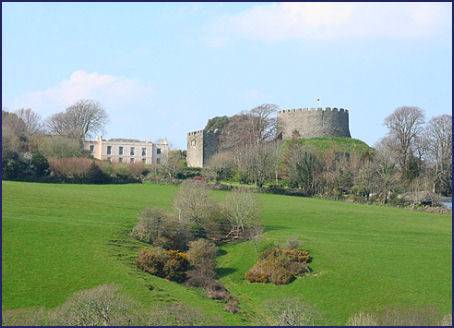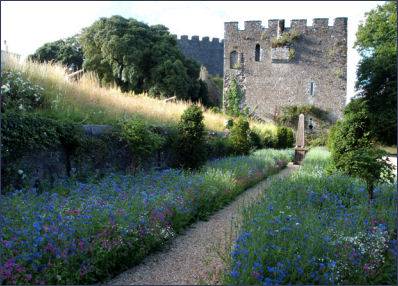Trematon Castle
OS Grid Ref:-SX 4158
 Trematon Castle is situated two miles southwest of the town of Saltash and occupying an emminence rising steeply from the River Lynher, it overlooks Plymouth Sound. The former Poet Laureate, John Betjemen, said it had "one of the most superb views of Cornwall, a Brunel stone viaduct crossing a foreground creek, the Lynher and Tamar estuaries beyond, and the wooded slopes of Anthony."
Trematon Castle is situated two miles southwest of the town of Saltash and occupying an emminence rising steeply from the River Lynher, it overlooks Plymouth Sound. The former Poet Laureate, John Betjemen, said it had "one of the most superb views of Cornwall, a Brunel stone viaduct crossing a foreground creek, the Lynher and Tamar estuaries beyond, and the wooded slopes of Anthony."
The castle is of similar design to Restormel Castle with a twelfth century shell-keep. It was constructed by on the ruins of an earlier Roman fort which occupied the site and was probably founded by Robert, Count of Mortain and Earl of Cornwall, half-brother of William the Conqueror. The castle is mentioned as being in his ownership in the Domesday Book of 1086.
An oval shell keep surmounts the motte and a plain curtain wall surrounds the bailey. The internal diameter measures approximately 21 metres. The well preserved rectangular gatehouse, probably added by Reginald De Valle Torta, dates from around 1270 and has two floors and a portcullis.
From the time of the Norman Conquest until 1270, the influential Valtetort family owned the rights for the ferry from Saltash Passage on the Plymouth side of the River Tamar to Saltash. At the time when when Reginald's descendant, Roger de Valletort, sold the castle to Richard, Earl of Cornwall, the second son of King John, the rent, which ammounted to nearly seven pounds, was paid to the Earl's bailiff. Since 1337 it has been in the ownership of the Dukes of Cornwall, a title traditionally held by the eldest son of the sovereign.
The Cornish people, following the abolition of the Latin Mass, rose in rebelion n 1549 against the compulsory use of the new English Prayer Book. Many of them still spoke the old Celtic Cornish language and English was a foreign language to them. Adreesing the boy king King Edward VI they declared, "..we the Cornishmen, whereof certain of us understand no Englyshe, utterly refuse thys newe serveses."
 Sir Richard Grenville and his protestants followers took refuge in the castle but were besieged there by some of the rebels. Grenville was persuaded the rebels would behave honourably if he would go outside and negotiate. At which he exited the castleand was seized and threatened with certain death, unless those inside the castle surrendered. The castle was then sacked and its occupants were stripped of their fine clothes and jewellery, some fingers being broken as rings were pulled from them. Sir Richard was taken to LauncestonCastle where he was imprisoned with other protestant Cornish gentry. They remained there until the rebellion was finally crushed two months later.
Sir Richard Grenville and his protestants followers took refuge in the castle but were besieged there by some of the rebels. Grenville was persuaded the rebels would behave honourably if he would go outside and negotiate. At which he exited the castleand was seized and threatened with certain death, unless those inside the castle surrendered. The castle was then sacked and its occupants were stripped of their fine clothes and jewellery, some fingers being broken as rings were pulled from them. Sir Richard was taken to LauncestonCastle where he was imprisoned with other protestant Cornish gentry. They remained there until the rebellion was finally crushed two months later.
When the Elizabethan seafarer Sir Francis Drake returned from his circumnavigation voyage in 1580, the gold, silver and precious stones, mainly emeralds, he had acquired from Spanish galleons were stored at the castle, before being moved to the Tower of London.
Within the Castle courtyard stands a Georgian house which was built in about 1808. Part of the original Castle wall was demolished to provide the house with a view of the surrounding countryside.
In 2012, garden designers Julian and Isabel Bannerman moved in to Trematon Castle and began to plant a garden which is intended to play to the Castle's romantic and pre-Raphaelite glories, the wild flowers, woodland and orchard, have been intensified with bold borders brimming with scent and colour. There is mixed woodland with dogwood and magnolia, tulip tree, foxglove tree and oaks. At the end of April the motte is a riot of wild flowers, carpeted with cowslips, bluebells, campion and purple orchids.
Image copyright Martin Bodman
Historic Buildings in Cornwall